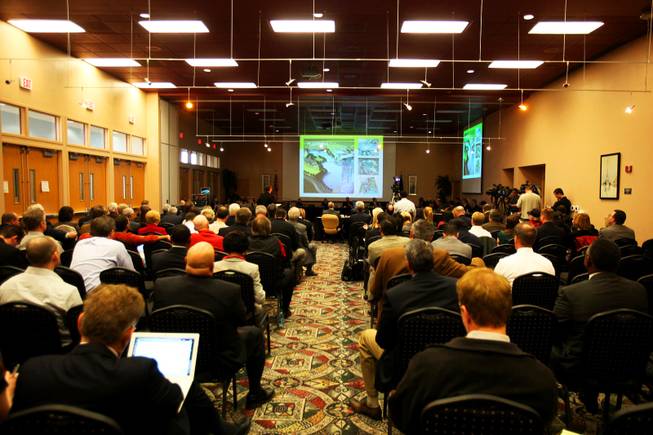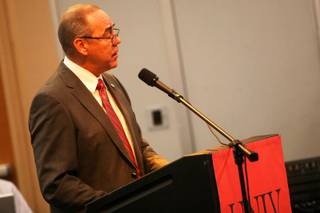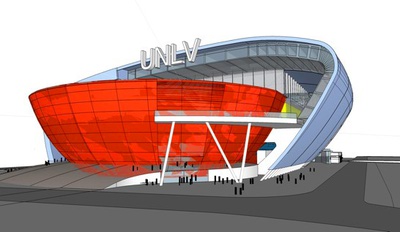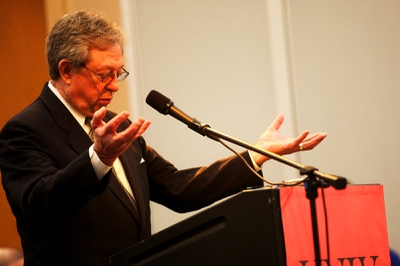
Craig Cavileer, president of the Silverton hotel-casino, presents a plan to the Board of Regents on Friday, Feb. 11, 2011, on the proposed UNLV stadium.
Published Friday, Feb. 11, 2011 | 12:13 p.m.
Updated Friday, Feb. 11, 2011 | 7:36 p.m.
Sun Archives
- Proposal emerges to build three-stadium complex in downtown Las Vegas (2-8-11)
- UNLV athletic department sees on-campus stadium as a game-changer (2-1-11)
- Developers put early plans for UNLV stadium, retail district on display (2-1-11)
- Regents to hear UNLV arena plan for football, basketball (1-31-11)
- Mayor: UNLV domed stadium wouldn’t conflict with a downtown Las Vegas arena (1-27-2011)
- Report: UNLV domed stadium plans will be unveiled Tuesday (1-27-2011)
- Goodman: Arena project a key issue for next Las Vegas mayor (1-20-2011)
- UNLV acknowledges effort to bring stadium, football to campus (1-19-2011)
The Nevada Board of Regents on Friday approved a 150-day agreement to negotiate with Majestic Realty Co. to build a 40,000-seat domed stadium on the UNLV campus.
If built, the facility could house UNLV football on campus and the Runnin’ Rebel basketball team would get a new home. The stadium also could house the National Finals Rodeo in December.
Following an hour-long presentation by Majestic and a parade of mostly favorable comments of support, regents voted 11-1 with one abstention to approve the exclusive agreement with the company that worked to build Los Angeles’ Staples Center and its nearby L.A. Live commercial district.
The 150-day agreement will enable Majestic and UNLV to develop details of a 150-acre mixed-use project that includes building the domed stadium and a university village with retail outlets and dormitory housing.
During the agreement period, UNLV would develop the necessary approvals and agreements governing land use on the site, which is on the west side of the campus near the Thomas & Mack Center.
UNLV and Majestic also will work to develop the financing necessary to build the project and get any needed legislative approval. During the 150 days, Majestic and UNLV would develop a long-term exclusive negotiation agreement to bring back to the regents for consideration.
A former Nevada governor and National Basketball Association all-star were among those who endorsed the project, described as a game-changer for UNLV.
Former Gov. Bob List called the proposal “an incredible opportunity,” and said Roski is “one of the best businessmen I’ve ever met.” He added that having such a project also would be a great educational experience for engineering and architecture students as well as those in the College of Hotel Administration to contribute ideas in the design of the project.
Four-time NBA all-star Spencer Haywood, who became a Las Vegas resident when the league brought its all-star game to the Thomas & Mack Center in 2007, said he believed the campus facility “would become a rallying point for the whole valley.”
Tom Thomas, a representative of the family that helped open the Thomas & Mack Center in 1983, also endorsed the project and applauded Roski’s business acumen.
But not everybody was in favor of the project.
Pat Lundvall, an attorney for rival sports facility developer International Development Management LLC, Austin, Texas, said her client was concerned about the preliminary assessment agreement and whether the deal would lock in an exclusive arrangement with Majestic.
“In essence,” she said, “you’re auditioning Majestic without any other competition. We feel you are obligated to have competitive bidding.”
Earlier this week, IDM unveiled the three-venue $1.57 billion Las Vegas National Sports Center. That proposal, identified for downtown Las Vegas, includes plans for a 17,500-seat arena for basketball and hockey, a 9,000-seat partially enclosed baseball stadium and a 50,000-seat partially enclosed football stadium. The baseball and football stadiums could be expanded to 36,000 and 75,000 seats, respectively, to host Major League Baseball and the National Football League.
The proposed complex would be located in downtown Las Vegas on 70 acres northeast of the World Market Center near the Spaghetti Bowl freeway interchange of Interstate 15 and U.S. 95. IDM said it would offer a $1-a-year lease to UNLV sports teams to play in the facilities.
When regents discussed the proposal, most of the controversy centered around the exclusivity of the agreement with Roski’s group.
Regent Mark Alden, who cast the only vote against the proposal, was concerned about signing an exclusive agreement, noting that Las Vegas Mayor Oscar Goodman advised him that dealing with one vendor would be a mistake. Regent Cedric Crear abstained. He’s a member of the nonprofit Las Vegas Arena Foundation board of directors, which has proposed to build a $500 million arena on land east of the Imperial Palace on the Las Vegas Strip.
Representatives of Roski’s team didn’t offer many additional details, including a cost estimate for the project, from the presentation it made Feb. 1. At that event, Roski, Silverton Casino president Craig Cavileer and UNLV President Neal Smatresk outlined the project’s master plan. In that presentation, Cavileer said the company would develop several funding sources, including a combination of private and corporate donations, developer equity, traditional bank debt and the establishment of a special improvement district to guarantee construction bonds.
Two Roski team members, Simon Sykes of Design Development Group and Dan Meis of Populous, added some detail of the type of environment the organization envisions at UNLV.
Sykes, who led a team in the development of Las Vegas’ Town Square, had a presentation showing the retail component of the project, which would include restaurants and food outlets and public spaces where people could picnic or gather for pre-game tailgate parties.
Meis, one of Time magazine’s 100 innovators in the world of sports for his work in the development of stadiums and arenas, explained some of the high-tech concepts envisioned for the domed stadium.
Noting innovative projects like the University of Phoenix Stadium in Glendale, Ariz., where the field surface can be moved in and out of the arena and the roof is retractable, Meis showed a concept of movable seating within an arena bowl. That’s how the facility could have 40,000 seats for a football game, but quickly transformed into a more intimate arena for basketball.
While the regents were dazzled with the innovative ideas, some of the big challenges for the project remained unanswered. Cavileer said finding the answers would be part of the work ahead in the next 150 days.
Among the challenges that have been identified are the reaction of the Clark County Department of Aviation and the Federal Aviation Administration to having a domed stadium built less than a mile from the end of McCarran International Airport runways and concerns about traffic egress from McCarran if Swenson Street is eliminated.
At Friday’s presentation, Cavileer said the project is not dependent on eliminating the Swenson Street access and the precise location of the stadium could change based on discussions with aviation experts.
Crear also tried to pin down an estimated cost from Cavileer.
“I know you guys have a number, I know that you have a thought process,” Crear said. “You guys have a number in your head and I think the board should know what that number is.”
But Cavileer replied, “We do not have a cost because we don’t have a project. What we have is a great plan and a great vision. The cost is going to be determined by the scale of the project, how much of the retail we actually develop, how many residential units are appropriate there.
“How big is the events center? Is it really 40,000 seats or is it 36,000 or is it 55,000? Does it really have a roof on it or does it not have a roof? These are all things that are yet to be determined,” he said.




Join the Discussion:
Check this out for a full explanation of our conversion to the LiveFyre commenting system and instructions on how to sign up for an account.
Full comments policy